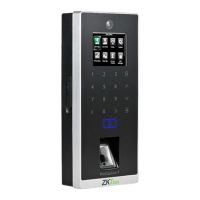
Do you have a question about the ZKTeco ProCapture-T and is the answer not in the manual?
| Type | Intelligent access control reader |
|---|---|
| Product color | Black |
| Cards capacity | 10000 cards |
| RFID frequency | 0.125 MHz |
| Fingerprint reader | Yes |
| Authentication type | Access chip/card, Biometric, Password |
| PC connection | RS-485/Wiegand |
| Supported network protocols | TCP/IP |
| Viewing angle, horizontal | 120 ° |
| Display type | TFT-LCD |
| Display diagonal | 2.4 \ |
| Operating temperature (T-T) | -10 - 50 °C |
| DC voltage range | 12 - 12 V |
| Power consumption | 500 mA |
| Flash memory | 0.256 GB |
| Internal memory | 0.128 GB |
| Processor frequency | 1200 MHz |
| Depth | 35 mm |
|---|---|
| Width | 87 mm |
| Height | 195.5 mm |
Instructions for correct fingerprint placement on the sensor for accurate verification.
Explains different methods like 1:N, 1:1 fingerprint, password, and card verification.
Describes the main screen display elements when the device is turned on.
Configuration for automatic time adjustment for Daylight Saving Time.
Process for adding new users, including super admins and normal users.
Configuration of access control parameters like group, time period, and duress fingerprint.
How to locate existing users in the system by their ID.
Procedure for modifying existing user information and settings.
Steps to remove user data, including specific details or the entire user profile.
Options to customize how user lists are presented on the device interface.
Steps to activate user role definitions for managing permissions.
Assigning specific operational rights to different user-defined roles.
Configuration of network parameters like IP address, subnet mask, and gateway.
Settings for serial communication, including RS485 functionality.
Establishing communication between the device and a PC, including Comm Key setup.
Assigning a unique identifier to the device for communication purposes.
Configuration for connecting to the ADMS server, including IP and port settings.
Configuration of Wiegand input and output parameters, and card format detection.
Configuration of how access records and photos are managed and stored.
Tuning fingerprint sensor sensitivity, match thresholds, and retry settings.
Procedure to restore device settings to their original factory defaults.
Steps for updating the device's firmware using a USB drive.
Customizing the device's display, language, timeouts, and slide show.
Configuration for voice prompts, keyboard prompts, and volume levels.
Setting up scheduled bells for signifying on-duty and off-duty times.
Options for deleting various types of data, including access records and photos.
Procedures for backing up device data to a USB disk or the device itself.
Steps to restore backed-up data from a USB disk or the device.
Configuring core access control parameters like lock delay and verification modes.
Defining time schedules for access control, including daily and holiday rules.
Managing holiday entries to adjust access control behavior on specific dates.
Setting up multi-factor authentication by combining different access groups.
Enabling and configuring anti-passback rules to prevent unauthorized entry.
Exporting data such as access records, user data, and photos to a USB disk.
Importing data such as user photos, screen savers, and wallpapers from a USB disk.
How to retrieve and view access logs based on time range and user ID.
Finding and viewing attendance photos associated with user verification records.
Locating and viewing photos of users flagged in the blacklist.
Functionality for displaying user photos during verification, if supported.
Overview of the Wiegand protocol and its application in access control systems.
Guidelines for preparing and uploading user photos, advertising images, and wallpapers.
Company's statements regarding privacy compliance and data collection practices.
Information on hazardous substances and the product's environmental friendly use period.